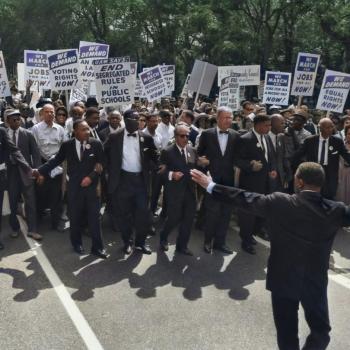Weekly episodes of the RavenCast can be viewed live on the Raven Foundation Facebook page. Recordings are posted on the Raven Review and on Teaching Nonviolent Atonement blogs. You can listen to the MP3 above, or watch the video below. Subscribe to the RavenCast on iTunes or Stitcher radio.
Students at Marjory Stoneman Douglas High School are rising up as new leaders. They refuse to respond to the tragedy at their high school with despair and are instead taking action. They have what theologian James Alison calls, “The Intelligence of the Victim.” They have special access to the truth about violence, and in particular, gun violence.
But the students haven’t taken on a “victim mentality.” Their message isn’t about revenge, but about society fulfilling a promise to protect and care for our children.
Sadly, many are trying to silence the voice of these students, claiming they are “paid actors” and working for the FBI. The students are naming the darkness in the world, and the darkness is trying to silence them. But their truth will not be silenced.
René Girard and the Scapegoat
René Girard states that in a scapegoating situation, the group is trying to expel its internal violence out onto a victim, blaming the victim for the discord in the community. Guns are symbols of this internal violence that is now being projecting onto high school students.
We do need to ban AR-15 rifles and other military assault rifles that are only meant to kill as many people in as little time as possible, but the underlying issue is a culture of violence that infects US culture.
We have stricter regulations for driving a car than we do for using a gun. This needs to change.
Children are pervasively scapegoated by our culture because adults run things according to what adults value. Children and adults need different types of environments. We aren’t keeping our children safe in schools or when they are walking to and from school. Children from Parkland, Florida to Syria are victims of the adult desire to get even. Until we begin to structure our decision process around what children need, as well as what adults need, we’re going to be stuck in these situations.
[tweetthis]We have stricter regulations for driving a car than we do for using a gun. This needs to change.[/tweetthis]
What can we do to change a culture of violence into a culture of peace?
A priest became the principal of a school for “troubled teens” who were kicked out of their high schools for bad behavior. He decided that he would intentionally create a culture that welcomed students at the school. For example, every morning he greeted the student and talked with them as they entered his school. In his decades of being a teacher and administrator, he never felt threatened by any student, largely because he and others created a culture of hospitality at the school.
Is the 90% of Americans who want stricter gun violence a mob?
Some Girardians claim that a large group of people who agree on anything is automatically a mob out for violence. But that’s not always the case. In fact, in his book Deceit, Desire and the Novel, Girard talks about the character M. de Renal in Stendhal’s book, The Red and the Black. M. de Renal believes in a lie. Girard says the whole world could come and tell that character the truth, and he still wouldn’t believe it. In this case, “the whole world” is not a mob, but a community that tells the truth.
Matthew 18 is another good example of a community that isn’t a mob. Jesus teaches that if you have an issue with a member of the church, go talk with that member directly. If they won’t listen, take another person, and bring more people. If they continue to not listen, treat them as a Gentile until they do. His way of treating Gentiles wasn’t to be violent with them, but as seen with the woman at the well and even Roman soldiers in Matthew 5, it’s to love them, even if they may not be a member of the church.
Matthew 18 also talks about our responsibility to children. If we put a stumbling block in front of them, it would be better for us to have a millstone wrapped around our necks and thrown into the ocean. These guns and the larger culture of violence, is a stumbling block for our children.
How Not to Scapegoat in the Gun Debate
Much of the gun debate centers around one side being over and against the other side. We can start to gain a sense of “goodness” by being in opposition to another. This sense of being good is a sign that we are scapegoating the other side. The real issue of gun violence falls away, and the issue becomes defeating our rival. That should not be the focus. The focus should be making our schools as safe as possible.
In this sense, mimetic theory helps us understand that we often get caught up in scapegoating. As Girard claimed, it’s easy to see another person’s scapegoat, but much more difficult to see my own. This is where we can help each other see our scapegoats. But we need a community, not a mob, to do this with each other.
Image: Maxpixels.
Stay in the loop! Like Teaching Nonviolent Atonement on Facebook!
















